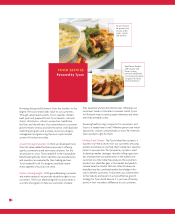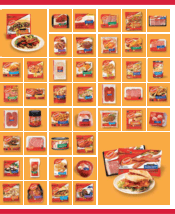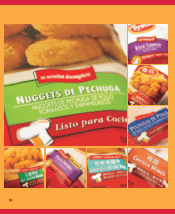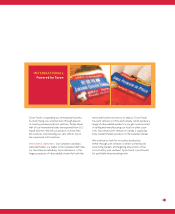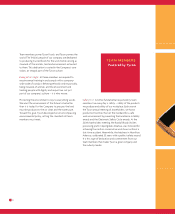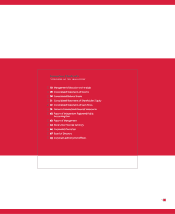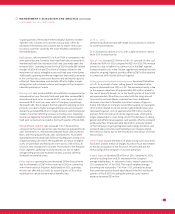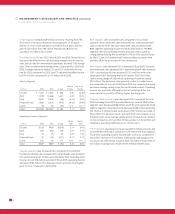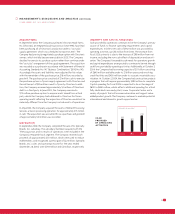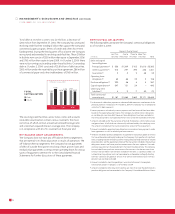Tyson Foods 2004 Annual Report Download - page 20
Download and view the complete annual report
Please find page 20 of the 2004 Tyson Foods annual report below. You can navigate through the pages in the report by either clicking on the pages listed below, or by using the keyword search tool below to find specific information within the annual report.
18
MANAGEMENT’S DISCUSSION AND ANALYSIS
Tyson Foods is the world’s largest protein company and the second
largest publicly traded food company in the Fortune 500 with
one of the most recognized brand names in the food industry. Tyson
produces, distributes and markets chicken, beef, pork and prepared
foods and related allied products. The Company’s primary operations
are conducted in four segments: Chicken, Beef, Pork and Prepared
Foods. Some of the key factors that influence the Company’s busi-
ness are customer demand for the Company’s products, the ability
to maintain and grow relationships with customers and introduce
new and innovative products to the marketplace, accessibility of
international markets, market prices for the Company’s chicken,
beef and pork products, the cost of live cattle and hogs, raw mate-
rials and grain and operating efficiencies of the Company’s facilities.
In August 2004, the Company introduced a new marketing and
communication campaign “Powered by Tyson.” This is the largest fully
integrated marketing campaign in Tyson history and is supported by
an investment of $75 million from the Company’s annual marketing
budget. To support the Company’s goals of building its value-added
product portfolio, Tyson developed 400 new products this year.
Additionally, the Company broke ground at its Corporate Center
for the construction of facilities that will house expanded product
development kitchens, a new pilot production plant, provide space
for the consumer insights group and make provisions for team
member development activities.
In fiscal 2004, the Company achieved record sales and earnings,
driven largely by the strong performance of the Company’s Chicken
and Pork segments. The Company continued to generate strong
cash flow in fiscal 2004, as cash flow from operations increased
$112 million from the prior year. This allowed the Company to pay
down debt by $242 million in fiscal 2004, and exceed the debt-to-
capital ratio goal of 45% by reaching 44% at year end. Earnings for
fiscal 2004 were $403 million, or $1.13 per diluted share, compared
to $337 million, or $0.96 per diluted share, in fiscal 2003. The increase
in earnings primarily was due to higher average selling prices,
improved operating efficiencies in the Chicken segment, increased
demand in the Chicken and Pork segments and improvements to
the mix of our value-added products. Earnings were negatively
impacted by higher grain costs, partially offset by the Company’s
on-going commodity risk management activities, higher raw mate-
rial costs and the continued limited access to export markets. Also,
fiscal 2004 pretax earnings included $40 million of costs, or $0.07
per diluted share, related to plant closings, $61 million of costs, or
$0.11 per diluted share, of BSE-related charges, $21 million of costs,
or $0.04 per diluted share, related to fixed asset write-downs and
$25 million of costs, or $0.04 per diluted share, related to the impair-
ment of various intangible assets. Fiscal 2003 pretax earnings included
$167 million received in connection with vitamin antitrust litigation,
$76 million of costs related to plant closings and $10 million of
charges related to the impairment of an equity interest in a live
swine operation.
The Company’s accounting cycle resulted in a 53-week year for fiscal
year 2004, and a 52-week year for fiscal years 2003 and 2002.
The Company’s goals for fiscal 2005 are to reduce the debt-to-capital
ratio to 40%, improve the mix of value-added products to over 40% of
sales and improve the return on invested capital to 14%. Additionally,
the Company anticipates expenses related to interest, foreign
exchange and other charges to be approximately $250 million and
the effective tax rate to be in the range of 36% to 37%.
Although uncertainty in global market conditions continues to
make it difficult to predict future product demand, the Company
believes the Chicken, Pork and Prepared Foods segments will be
strong in fiscal 2005; however, the Beef segment operations will
continue to be difficult. The Company anticipates stronger export
demand for chicken in fiscal 2005 due to the recent openings of
the China and Japan markets, the liberalization of the Taiwanese
market and the continuing emergence of the middle-eastern and
African markets. The Canadian border continues to be closed for
live cattle; however, the U.S. government has recently initiated a
review process to re-open the Canadian border. Also, while there
is a framework of an agreement for the resumption of trade with
Japan, it appears trade will not resume for several months. Currently
live weights of cattle being slaughtered are considerably higher than
last year, indicating supplies of cattle in the near term will be more
abundant; however, until international market access is restored and
live cattle are permitted from Canada, margins in the Beef segment
will be negatively impacted.


